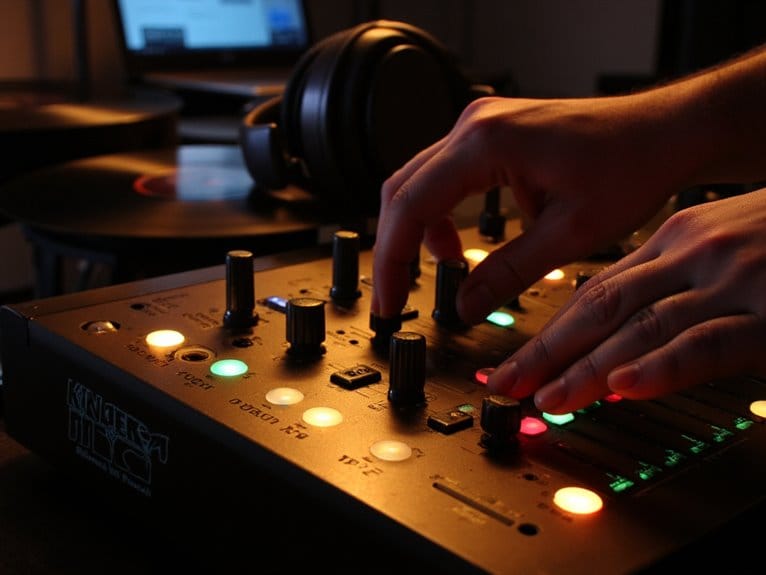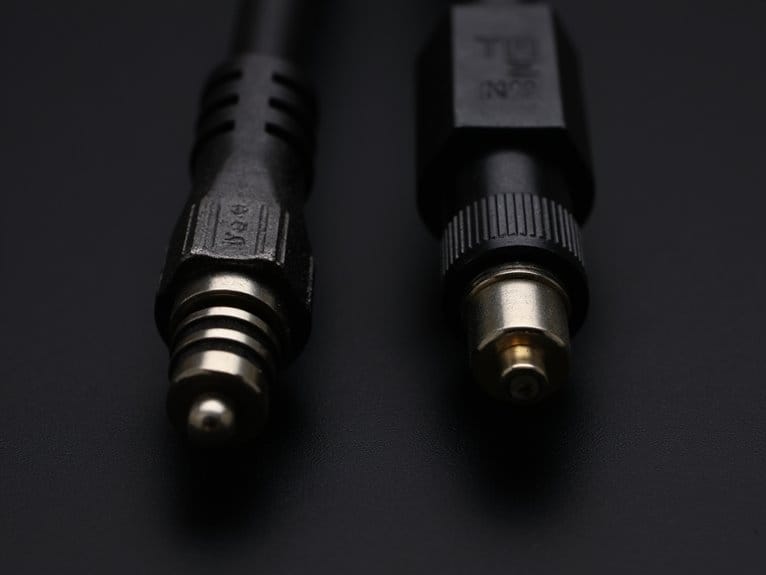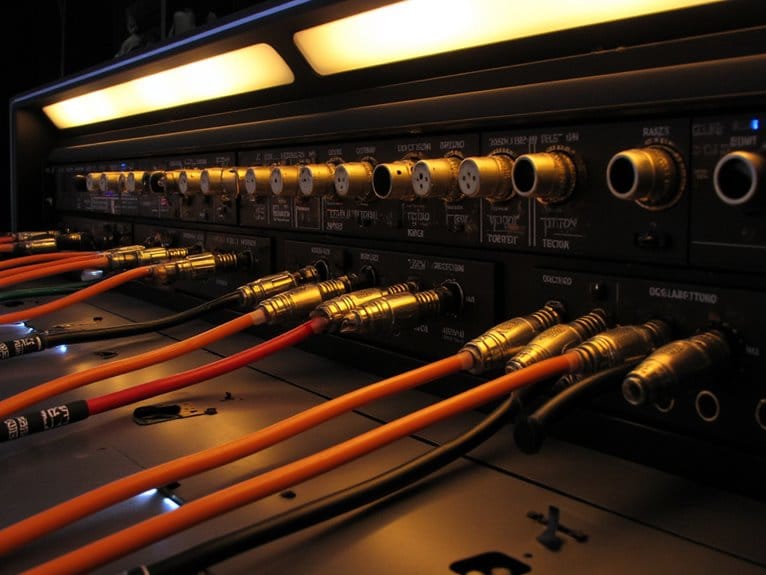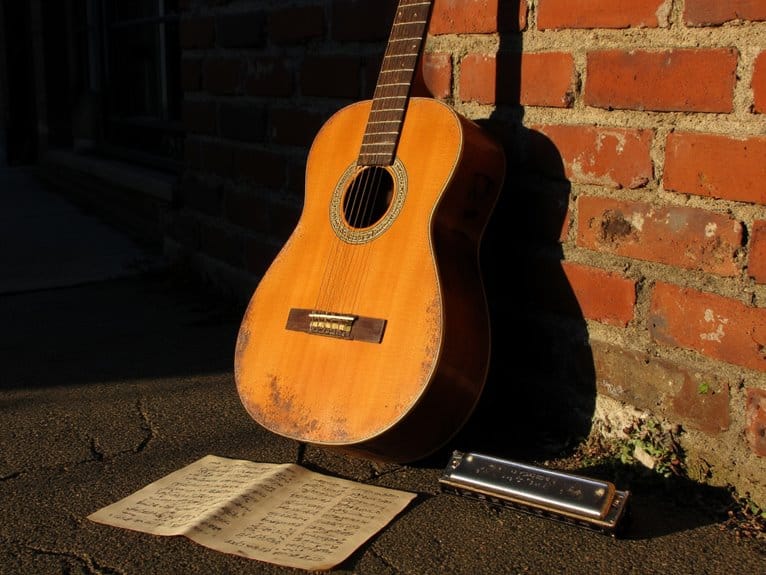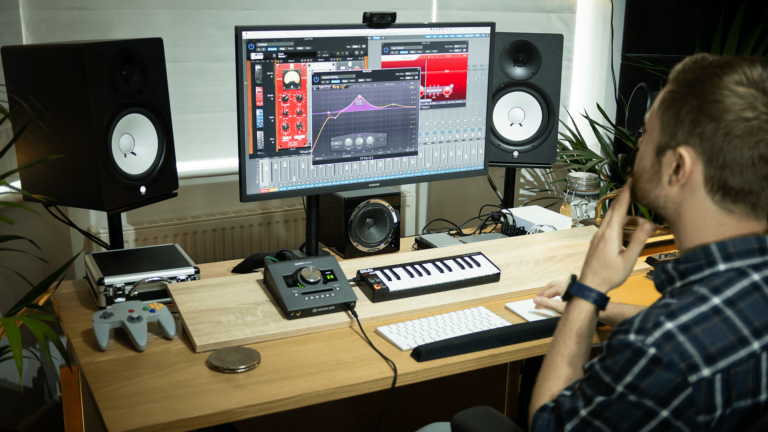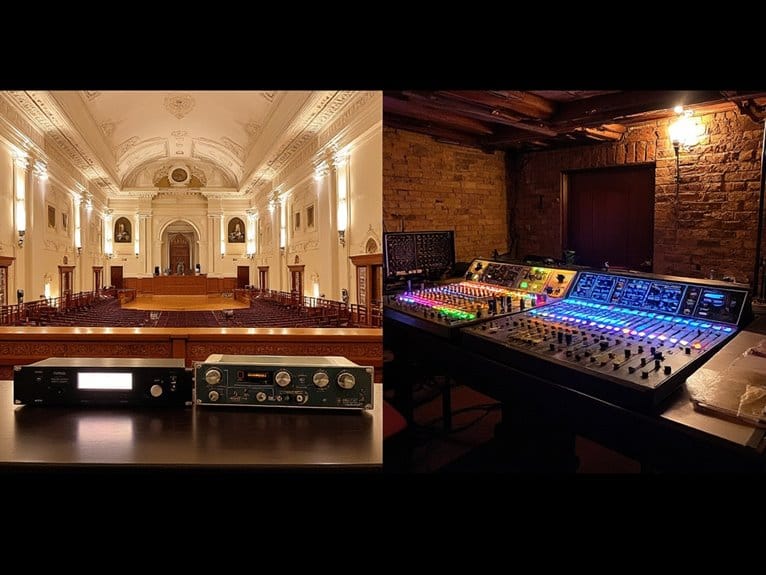Using Drum Samples and Loops Effectively
To use drum samples and loops effectively, you’ll need to select genre-authentic sounds like TR-808s for hip-hop or TR-909s for techno, then apply transient-based slicing at zero-crossing points to avoid clicks. Clean your samples through EQ adjustments, compression with proper attack settings, and strategic layering of one-shots over loops to fill rhythmic gaps. Master tempo synchronization using DAW detection tools and quantization for precise alignment. The techniques below will elevate your productions substantially.
We are supported by our audience. When you purchase through links on our site, we may earn an affiliate commission, at no extra cost for you. Learn more.
Notable Insights
- Choose drum samples that match your genre’s signature sounds, like TR-808s for hip-hop or TR-909s for techno authenticity.
- Slice samples at zero-crossing points using transient detection to preserve natural attack and decay while avoiding audio artifacts.
- Layer one-shot samples over drum loops to emphasize key hits, fill rhythmic gaps, and create fuller arrangements.
- Process samples with EQ to cut low-end rumble, compression for groove enhancement, and light reverb for spatial depth.
- Use DAW tempo detection and quantization to ensure samples sync perfectly with your project’s BPM and timing.
Selecting the Right Drum Samples for Your Genre
When I first started producing music, I’ll admit I made the classic mistake of grabbing any drum sample that sounded “cool” without pondering whether it actually fit my intended genre.
Trust me, you can immediately tell when a trap-style 808 kicks in during what’s supposed to be a jazz fusion track.
Nothing kills the vibe faster than dropping a heavy dubstep bass into your smooth bossa nova arrangement.
Developing proper sample discernment means understanding that each genre has signature sounds that maintain genre authenticity—techno demands those crisp Roland TR-909 kicks, while hip hop relies on the punchy low-end of TR-808s.
You’ll need to contemplate tempo ranges, rhythmic patterns, and sonic characteristics that define your chosen style, whether that’s the articulate dynamics of jazz drums or the synthetic textures of electronic music. Remember that affordable gear historically dictated which sounds appeared across different music styles, as early producers simply used whatever machines were accessible to them. Study reference tracks on platforms like Beatport and Spotify to understand how popular samples function within your target genre.
Chopping and Slicing Techniques for Creative Rhythms
After you’ve selected the perfect drum samples for your genre, the real creative magic happens when you start chopping them up. I’ve found that mastering slice techniques transforms static loops into dynamic, personalized rhythmic foundations that’ll make your beats stand out from the countless producers using the same source material.
Effective transient recognition becomes vital for maintaining rhythmic integrity while creating fresh patterns. Here are three essential chopping approaches I rely on:
- Transient-based slicing cuts samples precisely at each drum hit, preserving the natural attack and decay.
- Manual chopping lets you select meaningful segments by ear, capturing specific rhythmic elements that resonate with your vision.
- Zero-crossing point placement prevents audio artifacts and clicks, ensuring seamless shifts between slices for professional results.
Many producers enhance their workflow by connecting their chopped samples to MIDI drum kits that offer USB-MIDI connectivity, allowing for more expressive and dynamic performance of their sliced creations. Once you’ve chopped your samples, randomization & reordering opens up endless possibilities for creating unexpected rhythmic variations that breathe new life into familiar drum patterns.
Processing and Enhancing Your Drum Sounds
Once you’ve chopped your drum samples into workable pieces, the real artistry begins with processing and enhancement techniques that’ll transform raw audio into polished, professional-sounding elements that cut through any mix.
First, I always clean up my samples by trimming unwanted audio, normalizing volume levels, and crossfading edges to prevent clicks during playback.
Next, EQ adjustments become essential—cutting low-end rumble below 50Hz while boosting midrange frequencies around 200-500Hz adds body to kicks and snares.
Compression techniques follow, where I set attack times to preserve transients while adjusting release to complement the groove.
Finally, layering multiple samples with subtle reverb creates richer composite sounds that maintain impact while adding spatial depth.
If you’re looking to capture your own drum samples, understanding polar patterns is crucial for reducing bleed between drums and achieving cleaner recordings in both live and studio environments.
Combining Loops With One-Shot Samples
While loops provide that essential rhythmic backbone you need. I’ve discovered that strategically layering one-shot samples transforms static drum patterns into dynamic, professional-sounding arrangements that breathe with musical life.
Strategic layering of one-shot samples transforms static drum loops into dynamic, breathing arrangements that pulse with professional musical life.
Your layering techniques should focus on reinforcing key elements like kicks and snares without overpowering the original loop’s groove. I’ve found that blending one-shots at varied volume levels creates subtle augmentation that enhances rather than competes. Just like professional mixing consoles require phantom power for condenser microphones, your drum samples need proper gain staging to achieve optimal signal quality.
Here’s my approach to effective combination:
- Layer one-shots over loops to emphasize critical hits and create dynamic percussion emphasis.
- Fill rhythmic gaps with targeted one-shot placement, making arrangements feel fuller and less mechanical.
- Process samples separately using EQ, compression, and saturation for improved clarity within your mix.
This workflow balances speed with flexibility, letting you create unique rhythmic variations while maintaining that professional polish. When working with acoustic samples, remember that frequency response is critical for each drum element, as kick samples need low-end emphasis while snare samples require crisp articulation to cut through your mix. Just as power amp pedals require careful impedance compatibility with speaker cabinets, your samples need proper frequency matching to work seamlessly together in the mix.
Workflow Optimization and Tempo Synchronization
The magic of combining loops with one-shots quickly dissolves when your carefully crafted patterns drift out of sync. I’ve learned that mastering tempo synchronization isn’t just about technical precision—it’s about maintaining the creative momentum that keeps your workflow moving forward.
Your DAW’s tempo detection features become invaluable here, automatically identifying BPM metadata and enabling “fit to tempo” functions that stretch samples without pitch alteration. When beat matching fails, I rely on manual tap tempo and visual waveform analysis to nail down exact timing.
You’ll find that working with one-shot triggers instead of continuous loops prevents cumulative sync errors, while quantization guarantees precise alignment. Batch processing multiple samples and maintaining BPM-labeled libraries accelerates your entire production workflow considerably.
Frequently Asked Questions
How Do I Avoid Copyright Issues When Using Commercial Drum Loops?
When using commercial drum loops, you’ll need proper sample sourcing from reputable libraries with clear licensing options. Always read end-user agreements, choose royalty-free licenses, and document your purchases for legal protection.
Can I Use Drum Samples From Vinyl Records Legally in Releases?
You can’t rely on fair use interpretation for vinyl sampling legality. You’ll need proper clearance from both master recording and composition copyright holders before commercially releasing any drum samples from vinyl records, regardless of length.
What’s the Difference Between Royalty-Free and Copyright-Free Drum Samples?
Royalty-free means you’ve paid upfront with no ongoing fees, but copyright still exists. Copyright-free means no copyright restrictions at all. Both affect your sample usage differently regarding royalty implications and legal obligations.
How Many Drum Samples Should I Layer Without Overcrowding the Mix?
You should layer 2-3 drum samples per instrument using proper layering techniques. More than 3-4 samples risks muddiness and compromises mix balance. Focus on quality over quantity, emphasizing kicks and snares while keeping auxiliary elements minimal.
On a final note
You’ve now got the essential toolkit for transforming basic drum samples into professional-sounding rhythmic foundations that’ll elevate your productions. Remember, there’s no universal formula—what works brilliantly in trap might sound terrible in house music, so don’t be afraid to experiment with unconventional processing chains and sample combinations. Trust your ears, keep your workflow efficient, and you’ll develop that instinctive feel for making drums hit exactly right.

